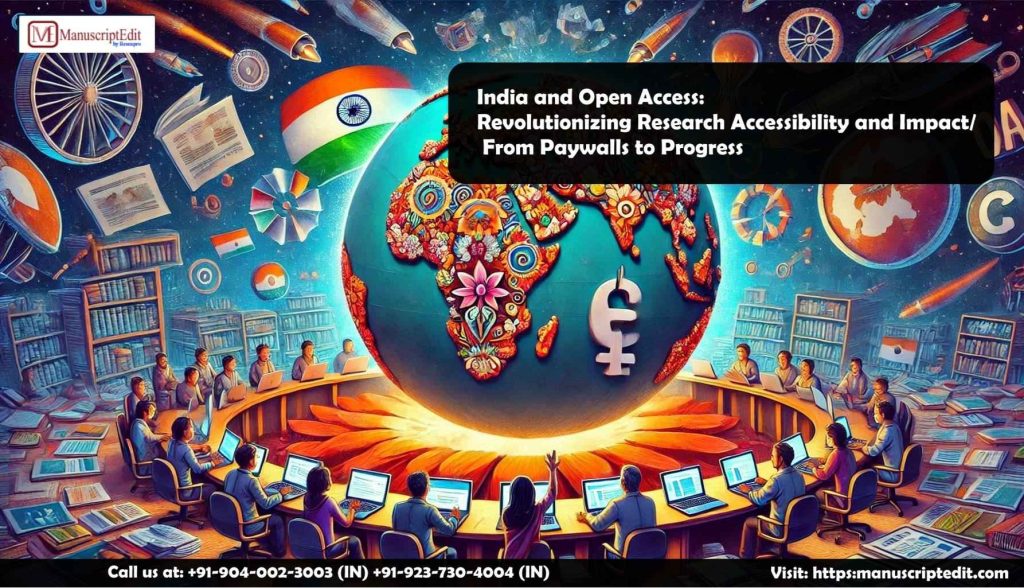|
Getting your Trinity Audio player ready...
|

India and Open Access: Revolutionizing Research Accessibility and Driving Impact
Imagine a world where groundbreaking research is locked behind paywalls, accessible only to a privileged few. Now, contrast that with a landscape where anyone, anywhere, can freely explore the latest scientific discoveries. This shift isn’t just a dream; it’s the reality brought about by open-access (OA) publishing.
Indeed, open access has a deep impact. According to Elsevier, the articles published under open-access reach 40% more downloads than subscription-based articles. Springer Nature, for instance, showed that citations average 12.9 for open-access journals and just 9.4 for traditional ones. Moreover, UNESCO observed that 72% of researchers in developing countries now depend on the OA journals for their work. This is another indicator pointing out the importance of OA in leveling the global playing field of scholarship. Beyond academia, open access empowers individual researchers, policymakers, and educators to tap into critical information without any restraints.
Whether a student of a resource-limited institution or an interested citizen scientist, knowledge indeed has no borders with OA. Furthermore, the more these digital platforms are developing, the easier and more open to access it gets, particularly in mobile-friendly formats and translated texts that increase universal understanding.
In this blog, we’ll uncover how open-access content has reshaped scholarly discourse, driving accessibility, visibility, and collaboration across the globe.
Open Access: A Revolution in Accessibility
What Are the Primary Ways Open Access Content Has Improved Accessibility for Researchers and the Public?
The most visible advantage of open-access content is that it is available to every person for their research.
- Global Reach: As UNESCO states, 72% of researchers in developing countries depend heavily on OA journals for scientific articles. With this easy access, researchers from all walks of life, where paying for subscriptions is too expensive, will have access to journals that allow them to connect and benefit from worldwide research developments.
- Availability of Research Information: Through public funding, more than 65% of research articles are now free to access. The European Commission claims this increases the possibilities for people outside academia to keep themselves informed of new developments in science and technology. Teachers and healthcare workers use open-access articles to do better work that better benefits the community, promoting positive change in the community.
- Assisting Lifelong Learners: More open-access journals have led to the rise of self-directed learning. The number of public access searches at sites such as PubMed Central has increased by 50% over the past decade. This way, the lifelong learner is not faced with the barriers of an institution in acquiring information.
How Does the Availability of Open Access Content Influence the Citation Rates and Visibility of Scholarly Work?
It very much affects the visibility of scholarly work through citation and accessibility.
- Springer Nature claims that open-access articles have an average citation rate of 12.9, while subscription-based publications average 9.4. This number indicates the higher impact and recognition that open-access (OA) works receive in the academic community, hence more frequent references in subsequent research.
- The journals that adopt the open-access policies see an increase in download and readership by an impressive 40%, according to Elsevier. The same visibility boosts an author’s impact while ensuring the research results benefit a large, diverse spectrum that includes cross-sectional studies and consequently encourages innovation in various fields, as well as collaboration across several disciplines.
- More Online Exposure: Social media networks like Twitter and LinkedIn facilitate the sharing of open-access articles. It can extend its audience considerably beyond the usual academic circles. And according to some reports, sharing online can boost engagement on articles by 25%. The increased visibility allows more readers in the industry and from politics.
Challenges in Scholarly Discourse Before Open Access
Limited Access
- Paywalls: A survey by ResearchGate found that more than 80% of researchers in less well-funded institutions consider the steep subscription fees an insurmountable barrier to accessing the required literature. Such a financial issue starkly contrasts the experiences of well-resourced and under-resourced institutions and hinders equal participation in discussions.
- Knowledge Silos: Traditional subscription models have prevented collaboration because research was locked within paywalled spaces. Researchers working on similar problems often did not know of each other’s work, which delayed progress. Such silos prevented innovation and slowed the spread of important discoveries.
Inequity in Knowledge Sharing
- Regional Inequalities: The World Bank reports that only 35% of African universities have access to the major journal repositories, which greatly limits their scope for contributing to research worldwide. In turn, regional researchers in low-income regions are handicapped from contributing significantly to global academic publishing, which perpetuates systemic inequality.
- Delayed Access for Practitioners: Healthcare providers and policymakers often encounter delays in gaining access to new research. Delays often stem from paywalls, which negatively impact the time taken to decide on action plans. For example, the timely difference between response and action might be crucial, saving lives and resources when the research is freely available, especially during a public health crisis.
Indian Significance of Open-Access Content
Open access is more than just a trend in India—it’s a necessity. With over 1.4 billion people and a rapidly growing research community, the demand for equitable access to academic content has never been higher. As per INFLIBNET, platforms like Shodhganga, housing over 400,000 Indian theses, and IndiaRxiv are integral to disseminating research globally. Furthermore, India’s Gross Enrolment Ratio (GER) in higher education rose to 27.1% in 2020, as per the Ministry of Education, emphasizing the need for accessible resources to support the burgeoning academic population. These efforts ensure that India’s scholars, regardless of geographic or financial barriers, can contribute to and benefit from global knowledge streams.
The Indian Academic Landscape
India, being one of the largest contributors to global research output, has significantly benefited from open access initiatives:
- Growing Research Output: As reported by Scopus, India ranks third globally in the field of research publication with over 150,000 papers produced each year. Open access is decisive to make this enormous reservoir of knowledge accessible to scholars worldwide, thereby increasing the overall impact of India on the world of research.
- Increased Accessibility: More than 70% of Indian universities depend on open-access repositories such as DOAJ and IndiaRxiv for academic resources. These platforms have effectively closed the divide between institutions with ample resources and those with limited access, democratizing information availability.
- Policy Support: Other government-led initiatives, such as the National Digital Library of India or NDLI, also provide impetus to the movement. NDLI gives free access to more than 60 million resources; this means free knowledge for each and every student and researcher of the country.
Societal Benefits in India
- Healthcare Innovations: Open access to medical research has revolutionized Indian healthcare. In the case of COVID-19, access to global studies allowed timely, informed decisions by Indian researchers and policymakers.
- Educational Impact: According to the Ministry of Education, more than 37 million higher education students rely on open-access materials for academic success. These are necessary for teachers and students in assignments, projects, and research.
The Future of Scholarly Publishing with Open Access
- Fostering Interdisciplinary Research: Open access removes the barriers of geography and finance, thereby encouraging interdisciplinary research. For example, UNESCO states that open access has doubled collaborative research between scholars in Europe and Africa over the past decade, which has improved innovation and bettered the response to global issues.
- AI Integration: Free availability of OA content makes AI-driven meta-analyses and systematic reviews much more feasible. For example, AI tools like semantic search engines depend on the OA databases for producing accurate and comprehensive results. The integration is revolutionizing the way researchers find patterns and synthesize knowledge.
- Policy Impact: Governments and institutions are mandating open access for publicly funded research. 85% of Horizon 2020-funded projects mandate OA publication, as recommended by the European Commission. The global precedent guarantees that taxpayer-funded research benefits the greater good of society.
- Innovative Platforms: New platforms, like the Open Science Framework, are even opening further possibilities for integrating open access with preprints and data sharing in addition to post-publication peer review processes. Such innovation is sure to bring more transparency and dynamics to scholarly communication.
Conclusion
It’s wonderful to see how open-access content has truly enriched the discourse in scholarship! With greater accessibility comes increased citation rates, and there’s a lovely sense of equity in sharing knowledge, making the exchange of ideas more inclusive, transparent, and collaborative in the academic world. As academic publishing continues to grow and transform, embracing open access isn’t just an opportunity; it’s becoming vital for building a research ecosystem that welcomes everyone globally.
Are you excited to have your research published in some of the most prestigious journals in record time? At Manuscriptedit, we’re here to support scholars like you in navigating the publishing process, regardless of your language preferences or academic discipline. Our comprehensive services in manuscript editing, journal selection, and submission assistance are designed to help your research truly shine.
Why wait? Connect with Manuscriptedit today and take that first step toward turning your academic publishing dreams into reality. Your success is just around the corner!



